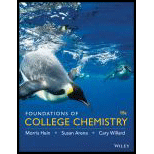
Concept explainers
(a)
Interpretation:
The given statement has to be identified as observation, hypothesis, theory, or scientific law.
The given statement is,
The battery in my watch must be dead since it is no longer keeping time.
Concept introduction:
Hypothesis:
A hypothesis is a reasonable guess based on the limited data which acts as a foundation for the further investigation. A hypothesis is not tested and proven scientifically and the results are uncertain and it relies on the possibility.
Theory:
A theory is a well correct explanation of a natural phenomenon that is validated through observation and experimentation and it is based on wide range of data. A theory is tested and proven scientifically, the results are certain, and it relies on evidence.
Scientific law:
A scientific law is the description of an observed fact. It does not explain why the observable fact exists or what causes it.
Example:
A scientific law predicts the results of unborn child’s possible hair colors or how far a baseball travels when launched at a certain angle.
Observation:
An observation is the act of noticing something or judgment from something seen or experienced.
(b)
Interpretation:
The given statement has to be identified as observation, hypothesis, theory, or scientific law.
The given statement is,
My computer must have virus since it is not working properly.
Concept introduction:
Refer to part (a).
(c)
Interpretation:
The given statement has to be identified as observation, hypothesis, theory, or scientific law.
The given statement is,
The air feels cool.
Concept introduction:
Refer to part (a).
(d)
Interpretation:
The given statement has to be identified as observation, hypothesis, theory, or scientific law.
The given statement is,
The candle burns more brightly in pure oxygen that in air because supports combustion.
Concept introduction:
Refer to part (a).
(e)
Interpretation:
The given statement has to be identified as observation, hypothesis, theory, or scientific law.
The given statement is,
My sister wears red quite often.
Concept introduction:
Refer to part (a).
(f)
Interpretation:
The given statement has to be identified as observation, hypothesis, theory, or scientific law.
The given statement is,
A pure substance has a definite, fixed composition.
Concept introduction:
Refer to part (a).
Want to see the full answer?
Check out a sample textbook solution
Chapter 1 Solutions
Foundations of College Chemistry, Binder Ready Version
- Identify and provide a concise explanation of a specific analytical instrument capable of detecting and quantifying trace compounds in food samples. Emphasise the instrumental capabilities relevant to trace compound analysis in the nominated food. Include the specific application name (eg: identification and quantification of mercury in salmon), outline a brief description of sample preparation procedures, and provide a summary of the obtained results from the analytical process.arrow_forwardIdentify and provide an explanation of what 'Seperation Science' is. Also describe its importance with the respect to the chemical analysis of food. Provide specific examples.arrow_forward5. Propose a Synthesis for the molecule below. You may use any starting materials containing 6 carbons or less (reagents that aren't incorporated into the final molecule such as PhзP do not count towards this total, and the starting material can have whatever non-carbon functional groups you want), and any of the reactions you have learned so far in organic chemistry I, II, and III. Your final answer should show each step separately, with intermediates and conditions clearly drawn. H3C CH3arrow_forward
- State the name and condensed formula of isooxazole obtained by reacting acetylacetone and hydroxylamine.arrow_forwardState the name and condensed formula of the isothiazole obtained by reacting acetylacetone and thiosemicarbazide.arrow_forwardProvide the semi-developed formula of isooxazole obtained by reacting acetylacetone and hydroxylamine.arrow_forward
- Given a 1,3-dicarbonyl compound (R1-CO-CH2-CO-R2), indicate the formula of the compound obtaineda) if I add hydroxylamine (NH2OH) to give an isooxazole.b) if I add thiosemicarbazide (NH2-CO-NH-NH2) to give an isothiazole.arrow_forwardAn orange laser has a wavelength of 610 nm. What is the energy of this light?arrow_forwardThe molar absorptivity of a protein in water at 280 nm can be estimated within ~5-10% from its content of the amino acids tyrosine and tryptophan and from the number of disulfide linkages (R-S-S-R) between cysteine residues: Ε280 nm (M-1 cm-1) ≈ 5500 nTrp + 1490 nTyr + 125 nS-S where nTrp is the number of tryptophans, nTyr is the number of tyrosines, and nS-S is the number of disulfide linkages. The protein human serum transferrin has 678 amino acids including 8 tryptophans, 26 tyrosines, and 19 disulfide linkages. The molecular mass of the most dominant for is 79550. Predict the molar absorptivity of transferrin. Predict the absorbance of a solution that’s 1.000 g/L transferrin in a 1.000-cm-pathlength cuvet. Estimate the g/L of a transferrin solution with an absorbance of 1.50 at 280 nm.arrow_forward
- In GC, what order will the following molecules elute from the column? CH3OCH3, CH3CH2OH, C3H8, C4H10arrow_forwardBeer’s Law is A = εbc, where A is absorbance, ε is the molar absorptivity (which is specific to the compound and wavelength in the measurement), and c is concentration. The absorbance of a 2.31 × 10-5 M solution of a compound is 0.822 at a wavelength of 266 nm in a 1.00-cm cell. Calculate the molar absorptivity at 266 nm.arrow_forwardHow to calculate % of unknown solution using line of best fit y=0.1227x + 0.0292 (y=2.244)arrow_forward
 Introductory Chemistry: A FoundationChemistryISBN:9781337399425Author:Steven S. Zumdahl, Donald J. DeCostePublisher:Cengage Learning
Introductory Chemistry: A FoundationChemistryISBN:9781337399425Author:Steven S. Zumdahl, Donald J. DeCostePublisher:Cengage Learning
